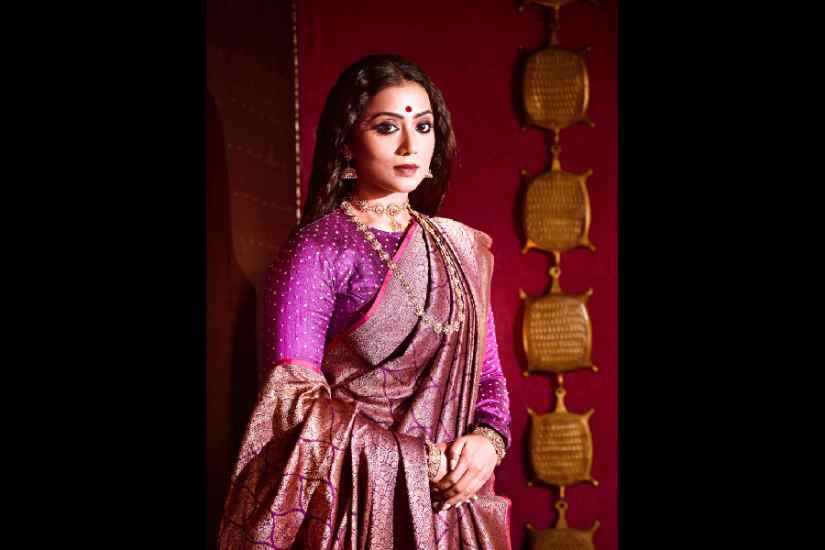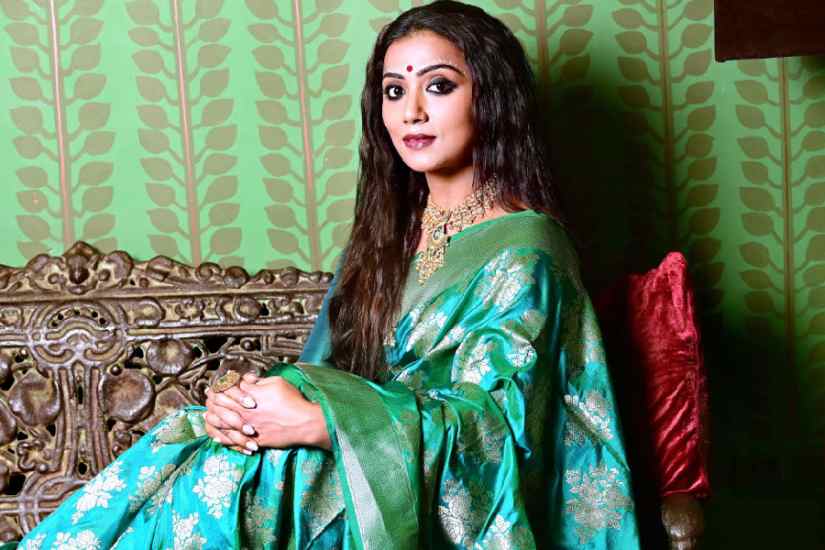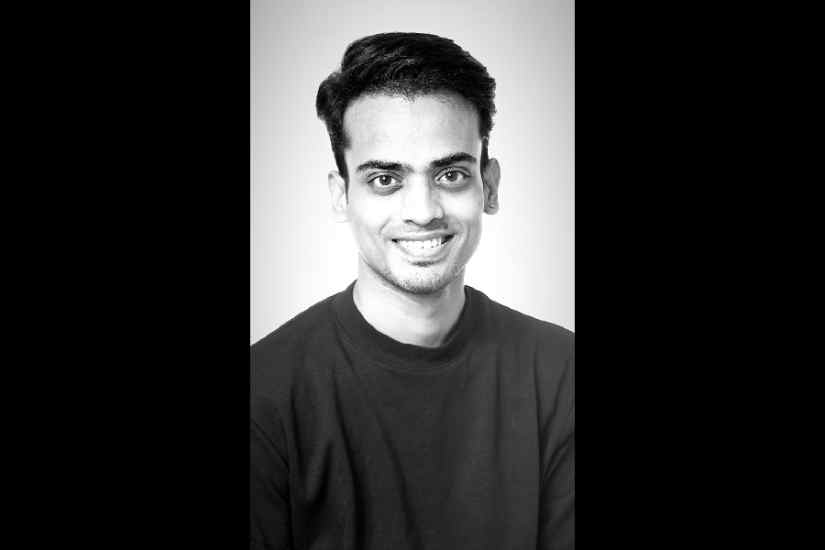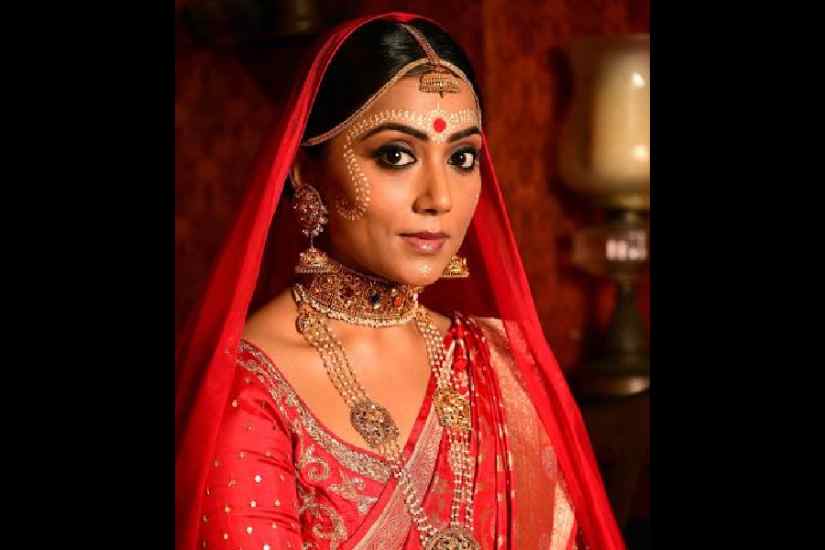A signature element that differentiates a Bengali bridal look from other Indian communities is the chandan art decorating the forehead and cheeks of the bride. Chandan art on a bride’s face has been intrinsic to a traditional Bengali bridal look since ages. The white sandalwood paste used in creating this art is considered auspicious and is culturally associated with Bengali brides, too. However, in recent times, contemporary Bengali brides often give it a miss in their bridal make-up to keep up with the trend of minimalism. Make-up artist Abhijit Paul, a pro in creating Bengali bridal looks, brings it back in his bridal looks showing how to sport this traditional trend differently with different designs of chandan art. Our muse for the shoot? Actress Anindita Bose. On the sidelines of this make-up shoot at Sonar Tori restaurant in Salt Lake, Anindita revealed to t2 a lesser-known side of her — the artist Anindita.
A lot of people know actor Anindita but not many people know artist Anindita. How and when were you introduced to art?

For brides who want to ditch the bright red and go for minimal make-up with a traditional touch, this look is apt for the D-day. Anindita wore a handwoven silver kadhua Benarasi with jamdani weave border. The dark maroon sari is complemented with simple make-up with classic kohl eyes, a small bindi and middle-parted bun. Kaan chandan style of chandan art highlights this look with a combination of kalka and dot motifs drawn beside the ears. Perfect for those who don’t want to keep the chandan art in an elaborate manner
I don’t think I have a clear memory as to when I was introduced to art but I heard when my rice ceremony happened, I touched the paintbrush and the wax crayons first on the plate. That is when my parents got to know that I would be doing something creative. For me, since childhood I have just been into painting, drawing and creating shapes.
Do you have any formal training in it?
I formally trained in it throughout my school life. I was trained for two exams — elementary and intermediate. Those are the exams that one has to give to get into any kind of art college and after that I did my bachelor’s at Sir J.J. School of Art and I majored in ceramics and painting there.
What is art to you and why is it important to you?

Abhijit decked up Anindita in a contemporary bridal look in this purple handcrafted katan and silk brocade Benarasi. He chose minimal make-up with black smokey eyes and a touch of pink on the lips, kept the hair open and added a small bindi to complete the look. The chandan art, combining kalka and dots around the bindi and at the end of the eyebrows on either side, added an edgy and elegant touch, complementing the overall contemporary vibe of the look
Art to me is my way of expressing what I am feeling. I know I am an introverted person, so it is very difficult for me to express my emotions or what I am feeling at a certain point sometimes. I don’t even know that I am feeling a certain way of emotions and somehow that is why art is extremely important to me because it is my way to let out my emotions and get my creativity flowing.
Has your way of perceiving art changed over the years?
The way I perceive art has definitely changed over the years. When I was younger it was quite difficult for me to understand some of the abstract paintings. But when I grew up I understood it is not supposed to mean anything, it is supposed to make you go through certain kinds of emotions and somewhere with that kind of understanding I feel even my art has become more mature.
What are your chosen mediums and is there any particular style that you practice?
Watercolor and acrylic and sometimes I do digital and oil. And I think my style is inspired by the artists that I really look up to. I think I have got an influence of Dali in my work. I have got an influence of Jamini Roy and Andy Warhol. I think I would term my work cubism mainly, that’s the style I follow.
Though you do a lot of sketching and doodling, too, your canvases are often very vibrant, quirky and full of life… what kind of stories do you like to capture on your canvases usually?
I definitely love colours and I love what these colours make me feel. What I usually like to capture in my canvas is mainly everyday life. I would say a slice of life. Someone enjoying time in nature or water, I like to come up with a story about it in my head and that is what I eventually end up putting on my canvas.
Is real-life Anindita also this vibrant, quirky and so full of life or a little more introverted?

In this reception look, Anindita draped a katan silk Benarasi featuring the gulab buta in a contemporary style. The make-up was kept simple with smudged kohl eyes and a tint of maroon on the lips, completed with the hair worn open. Abhijit showed a simple chandan art style in this look by drawing it only on the forehead in a double line with dot motifs, leaving out the kalkas
I think I am vibrant and really quirky and funny and full of life and hopeful and positive. I think I am all of that and along with that a bit introverted so I am a bit of both. I think I choose my people in front of whom I can be myself and the lucky chosen ones are able to see the quirky side of me.
Is your art inspired by your lived experiences too or just by what you observe?
I think it is a bit of both. My art is inspired by my life experiences or things that I observe. Especially, when I am travelling. I see a lot of things and observe a lot of things and maybe feel a lot of things while observing and those are the things I put down on my canvas.
As an artist do you also seek solace in art when life throws a storm at you?
When I think I am going through a little rough phase emotionally, I just immerse myself in art. Days pass by and I draw and paint continuously. As I am an introverted person, it gets so difficult for me to express my emotions so then I start doing that through my artwork.
Though you grew up in Bombay and now mostly live there, is there any aspect of Bangaliana that you hold close to your heart?
Every year I used to see my mom give alpona and every year during Puja she would draw the alpona right outside using rice paste and I remember I would sit there and watch her make it because it would mesmerise me. Chandan art I learnt when I moved to Calcutta and all the weddings that I attended. I saw beautiful chandan art done on the face and it was so artistic and the women look so beautiful in it. I love that we have it in our culture.
Calcutta has inspired artists of various mediums. Has it ever inspired your art?
I have always really loved painting but once when my cousin was studying in Santiniketan, I went and saw the Kala Bhavan building. That is where I thought I wanted to do something in art. I wanted to study there but eventually that didn’t happen because I got in J.J. But visiting Kala Bhavan had triggered my artist instinct and I knew that this is what I wanted to do.
Artist Anindita or actor Anindita, how do you like to express yourself best?
I like to express myself best as artist Anindita.
You told us how Rituparno Ghosh’s Gaaner Opare was one of your first projects as an actor and though you thought of leaving Tollywood soon to move to Bombay but eventually stayed back. How has working in Bengali films helped you to grow as an actor?
I decided to stay back cause Rituda’s (Rituparno Ghosh) schooling helped me to fall in love with the medium and fall in love with acting and making a character my own. I think after I did Jhinuk in Gaaner Opare I got so many more interesting roles and maybe people understood that I could do so many more interesting characters. And so I stayed back and kept doing this. I think working in Bengali films has helped me to grow as an actor because of the amount of faith and confidence my directors and producers showed in me. That automatically made me more aware of the kind of responsibility that was given to me so it made me work on my characters more.
How else would you like to explore yourself as an actor in this industry?
Well, I think I have pretty much done different things. I would love to explore by being a part of an action film or perform in a film, like do a dance number. These are things I have still not done... do a period piece or mythological piece.
Rapid Fire with Anindita:
An artist whose works inspired you
Frida Kahlo.
An artist whom you would like to meet or wished you could have met
I really wish I could have met Satyajit Ray. He was an all-rounder and the storyboards he made were full of characters and so quirky.
An actor you feel would be able to use a blank canvas best with their creative potential
I think Surangana is quite an artist. She is immensely talented. She really surprised me. I would like to see her artwork and put her creativity on a canvas.
If we pick these colours from a colour palette, which actors do these remind you of:
Red: Ritudi (Rituparna Sengupta). Her iconic red lips.
Green: Bumbada (Prosenjit Chatterjee). Because he is evergreen. He doesn’t get old and doesn’t cease to surprise you
White: Ridhima (Ghosh). She is really pure and she has got such an honest heart and soul.
Blue: Arjun Chakrabarty. He fits the blue colour
Black: Sohini Sarkar. Cause I find the colour black pretty sexy and I find her also pretty sexy.

“Chandan art has always been a part of the traditional Bengali wedding. Without it a Bengali wedding is incomplete. Brides only wear it on the forehead nowadays but through this lookbook I wanted to show how they can wear it on the cheek too and experiment with it in different ways with whatever look they choose for their wedding, be it traditional or contemporary. As a make-up artist who decks up brides very often, I feel chandan can beautify the Bengali bridal look even more and add a different touch to each look by experimenting with the traditional motifs and design,” said Abhijit Paul.
Saris: Mitan Ghosh
Blouses: Raj Banerjee
Hair and make-up: Abhijit Paul
Assisted by: Sananda Mondal Laha
Jewellery: B. Sirkar Johuree
Location: Sonar Tori
